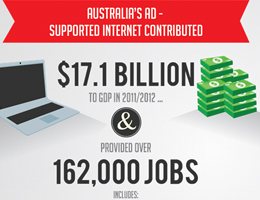
Publication: IAB UK, Samantha Yorke, 1 August 2013
The ad-funded internet contributed $17.1bn (£10.2bn) to the Australian economy in 2011/2012. Samantha Yorke, Director of Regulatory Affairs at IAB Australia, digs deeper into the figures.
Here at the IAB Australia, we’ve been observing the astonishing growth rates being attributed to internet advertising and wondering how our industry’s contribution to the broader economy compared with other industry sectors. We tasked our good friends at PwC, who compile the quarterly and annual online advertising expenditure report, to carry out some broader economic research and here’s what they discovered.
$17.1bn (£10.2bn) contribution to Australia’s GDP in 2011/2012
In an attempt to get our heads around which businesses should be included in assessing economic contribution, we identified three categories of businesses which relied on an advertising funded business model – either entirely, partially or interdependently.
Core sectors, which are funded entirely, included businesses which could not survive without online advertising – these included search engines, free social networking services and free content based websites. These businesses contributed $3.4 billion (£2 billion) to Australia’s economy.
Partial sectors counted businesses which had other income streams, such as subscriptions or labour / expertise costs and which were partially funded through advertising. Businesses such as ISPs, internet consultants, and technology providers contributed $9.7 billion (£5.8 billion) to the broader economy.
Finally, an interdependent sector was identified which was likely to exist without online advertising but which did derive benefits from advertising. This sector would include ecommerce sites and paid media and entertainment sites and was responsible for a $4 billion (£2.4 billion) contribution.
Looking forward, the sum total contribution of these sectors is forecast to reach $26.5 billion (£15.7 billion) by 2017 with a compound average annual growth rate (CAGR) of 7.5%, outpacing most other sectors of the Australian economy.
162,000 jobs created, many of which did not exist five years ago
PwC used the same sector breakdowns to calculate the number of jobs that have been created within the advertising funded internet industry.
The core sector is responsible for 40,200 jobs, the partial sector 60,000 jobs and the interdependent sector 62,000 jobs. Such roles include: many digitally focussed agency jobs; employees of businesses engaging in each of these sectors; advisors and consultants who specialise in internet advertising; engineering and web development roles which are responsible for building the technical infrastructure upon which internet advertising is enabled; and the growing number of data strategists who analyse data gathered from interactions with digital advertising.
Social welfare benefits – what value is attributable to the content and services which are made available by advertising funded business models?
PwC developed a methodology to measure the value, in dollar terms, that the advertising funded Internet brings to both consumers and producers. We were keenly aware of the enabling impact that this brings to broader communities in terms of access to information, connecting people and feeling included in broader society but it is frankly too difficult to put a dollar value on this at the moment.
We were however able to borrow a framework used by the Australian Productivity Commission to assess the social welfare benefit to consumers and producers. Consumer benefits included:
– Decreased transactional costs for goods and services due to increased competition and access to international suppliers
– More choice and opportunity to provide feedback to suppliers
– Availability of new products and services which may not yet be available through bricks and mortar businesses
The consumer value of this was estimated to be $43 billion (£25.5 billion).
Producer value focused more on the efficiencies of scale of the Internet and the ability to reach a global audience online. These values were estimated to be in the range of $27 billion (£16 billion). Which is very impressive.